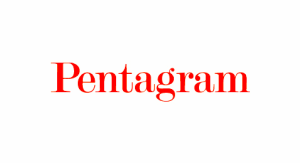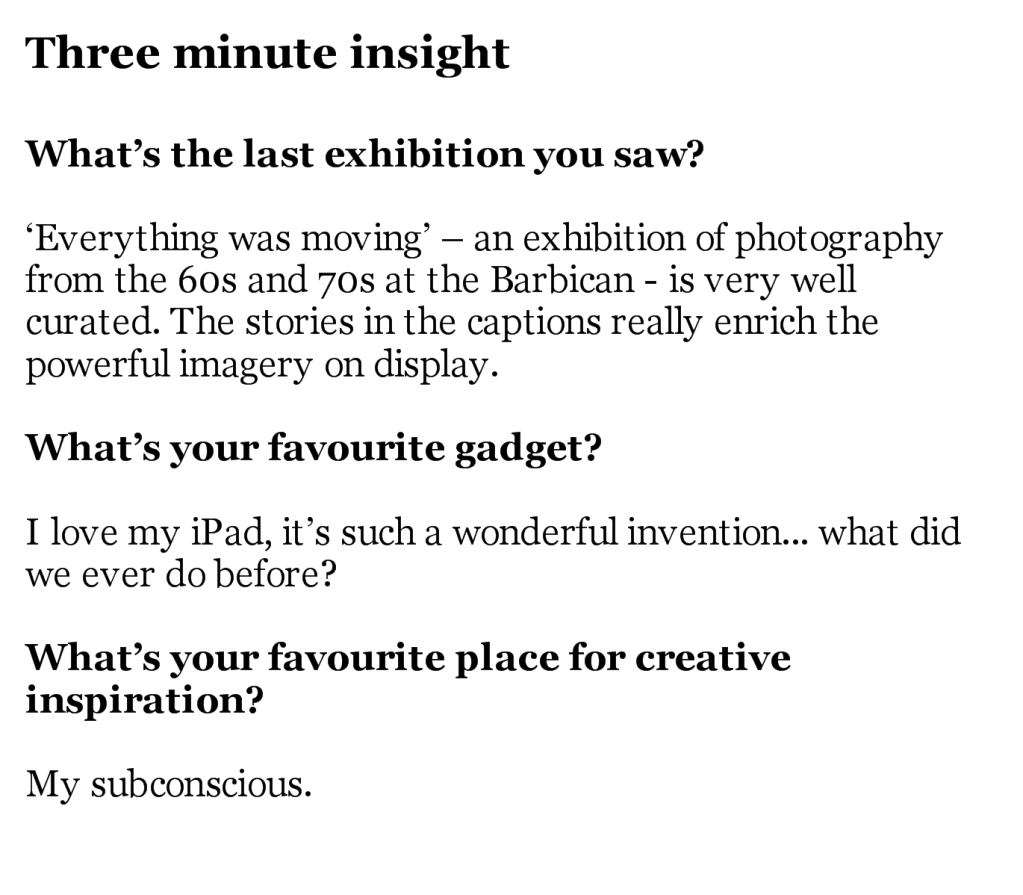Designer Soapbox: Gill Thomas
Gill Thomas has played many roles since she left Liverpool Poly with a fresh BA Hons in Graphic Design. She’s been a designer, team leader, creative partner and board director. She’s worked for some of the most influential design agencies around, including Pentagram, Newell & Sorrell and The Partners, and her clients have ranged from the BBC and Virgin Atlantic to the Design Council. She’s also witnessed huge changes in the design industry.
Here she talks about her work in the new Throwaway Lines exhibition, her latest role as an independent creative consultant, and her thoughts on writers and the design business today.
You’re currently taking part in the Throwaway Lines exhibition at the Free Word centre. What was it like creating a frame for the short story?
Andy Hayes gave me the scrap of paper that inspired the short story ‘Ella does some remembering’ by Nick Parker. The writing said ‘TWIST STEPPER WITH BUNGEE-CORDS’, and the story was about a woman who tries to recreate happy childhood memories. At the beginning she’s on an exercise machine, imitating the feeling of running on the top of Box Hill with a kite; at another point, she’s microwaving geraniums to remember the smell of summer at her grandparents’ house.
I liked the fact that the story was about a woman going back to her childhood, so I created a childlike Teletubby-esque frame that was covered with very green fake grass and daisies, with a kite that flew away from the frame. I researched sticking Astroturf onto wood and ordered lots of artificial daisies. I had to order the daisies twice. A hundred daisies are still on their way to me from China! Then I took all the elements into the kitchen and stuck them together with a glue gun. I felt it looked quite naive, which was the point.
What is wonderful in the exhibition is the contrast of so many different ideas. People put a lot of thought and effort into them. A lot of the stories were quite dark and challenging. I was pleased I got such an optimistic, fun, energetic story.
Going back to the start of your career, what first inspired you to become a designer?
I was always good at art at school and thought it would be a good thing to do as a job. But it turned out that there’s a bit more to it than that!
How did you find your first job?
I found my first proper job by chance. I was helping out a friend in a small design studio in Notting Hill. While I was there someone mentioned that there was a company around the corner who were looking for junior designers and maybe I should go and see them in my lunch hour. I’d not actually heard of them but thought it would be worth a look. That company turned out to be Pentagram – and after three interviews I was in.
What work do you do?
I do three types of work.
- I work with boards and brands on positioning. Because of my experience in both the visual and strategic sides, I’m a good bridge between an organisation that’s commissioning the positioning work and the agency that’s going to bring it to life visually and develop the final communications.
- I also help smaller agencies decide where they’re going or help them refocus how they work. I started as a junior designer, then moved up to being on the board of a reasonable sized business, so I more than likely have the breadth of experience to relate to the issues that a small business is likely to be facing. I can work with them to review where they are, where they want to go, and give them pointers on how to get there.
- My other area of work is naming. I really enjoy the challenges of naming projects, because they combine logical and creative thinking. A name has to be spell-able, say-able, url-able, culturally accept-able, own-able and it needs to be the start of a story. The legal aspects can be a real challenge but sometimes if you come at it from left field, you’ve got a chance of finding a name that will really make a difference to an organisation and please the lawyers.
How have your thoughts about writing changed over the years?
As a junior designer, I was always more interested in pictures. I thought the copy was just grey stuff to drop into the visuals and probably didn’t even read it. But after a few years, when I started working at The Partners and gained more experience, I realised that the copy had a job to do. The words had to communicate something and make a difference. They are, of course, very important in creating a brand and positioning a business.
What qualities do you look for in a writer?
Apart from having a talent for writing, it’s also important that writers listen, and understand that they’re part of a team.
If I put a writer in front of a client, I want to be confident that they’re informed, that they understand the client’s business, their peers, their competitors and their offer. They have to be keen to find out about the client’s culture, how they like to work and what kind of people they are. A writer will be brought in at a certain stage of the project’s journey, so they need to understand:
- What stage the client has reached
- How they have got there
- What has worked well so far
- What hasn’t
- What’s appropriate to say at that point.
If a team has just spent months defining a brand and its positioning, we’re not necessarily looking for new ideas. We’re probably looking for a clear and concise articulation of the information we’ve gathered so far.
Particularly in this climate, it’s vital to make sure the client is comfortable with what the project team is doing. So that means building on the trust that the agency has already created, and not throwing in a curve ball or lots of options when that’s not part of the brief.
What kind of writing do you prefer?
The Partners was a highly creative world, and we often used to work with writers who’d been in advertising, ideas-based writers who wanted to play. They wrote witty, clever headlines, and I enjoyed that playful, creative approach.
But sometimes a more straightforward approach is needed. It’s important that writers enjoy what they’re writing and are passionate about their work, but sometimes overly complex language can get in the way of the message.
Occasionally writers seem to think they need to do more, add more, when in fact an extra metaphor can confuse a positioning statement. More often than not, I need writers to be clear and precise.
How’s business at the moment?
I’m as busy as ever, but no one’s taking any risks at the moment, so there are more smaller projects and tactical work. But because clients are nervous of making big decisions, they are looking for a more focused approach. As an independent, I can offer the perspective and experience of years spent working for large agencies, and I can also be flexible, offering a few days here and there which can really make a difference to a project.
It will be interesting to see what happens when we finally come out of this recession. Clients have got used to being pragmatic, pared down and engaged at a real level, working with agencies and consultants who understand and focus on where they can add real value to a client’s business. I think they’ll still want that approach, but will also appreciate fresh thinking, confidence, directness and the energy of good ideas.




